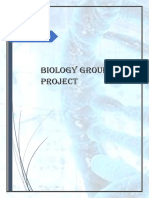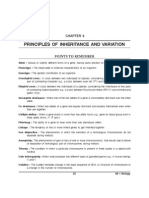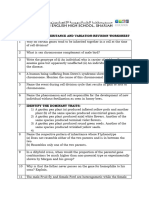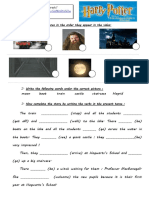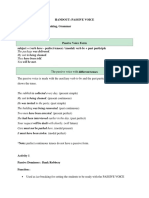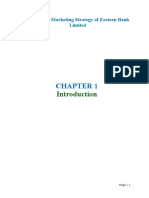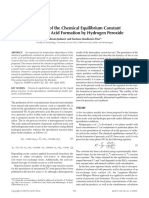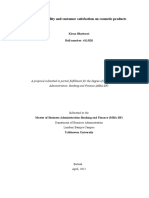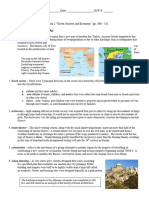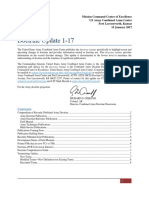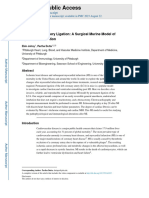HOLIDAYS HOMEWORK
DAV PUBLIC SCHOOL, SRESHTHA VIHAR
CLASS XII
BIOLOGY ASSIGNMENT
CHAPTER-PRINCIPLES OF INHERITANCE AND VARIATION
ANSWER THE FOLLOWING QUESTIONS:
Q1 State the chromosomal defect in individuals with Turner’s syndrome.
Q2 Name the event during cell cycle that results in the gain or loss of
chromosomes.
Q3 What is polyploidy?
Q4 A pea plant with purple flowers was crossed with white flowers producing
50 flowers with only purple flowers. On selfing, these plants produced 482
plants with purple flowers and 162 with white flowers. What genetic
mechanism accounts for these results? Explain.
Q5 During a monohybrid cross involving a tall pea plant with a dwarf pea plant,
the offspring populations were tall and dwarf in equal ratio. Work out a cross
to show how it is possible.
Q6 With the help of one example, explain the phenomenon of co-dominance
and multiple allelism in human population.
Q7 Why did T.H. Morgan select Drosophila melanogaster to study sex-linked
genes for his lab experiments?
Q8 In a dihybrid cross white eyed, yellow bodied female Drosophila crossed
with red eyed brown bodied male Drosophila Produced in F2 generation, 1.3
percent recombinants and 98.7 percent progeny with parental type
combinations. This observation of Morgan deviated from Mendelian F2
phenotypic dihybrid ratio. Explain giving reasons.
Q9 Explain the mechanism of sex determination in birds.
Q10 Name the kind of diseases/disorders that are likely to occur in humans if:
(a) Mutation in the gene that codes for an enzyme phenylalanine
hydroxylase occurs.
1
� (b) There is an extra copy of chromosome 21.
(c) The karyotype is XXY.
Mention any one symptom of the diseases/disorders named above.
Q11 What is Down’s syndrome? Give its symptoms and cause. Why is
that that the chances of having a child with Down’s syndrome increases
if the mother exceeds forty years? (NCERT Exemplar)
Q12 What is aneuploidy? Differentiate between trisomic and triploid
condition. Name any one trisomic condition found in humans.
Q13 During a cross involving true breeding red flowered and true
breeding white flowered snapdragon plants, F1 progeny did not show
any of the parental traits, while they reappeared in F2 progeny. Explain
the mechanism using Punnett square.
Q 14 Explain Polygenic Inheritance with the help of an example.
Q15 What is point mutation? Give one example.
Q16 State the law of independent assortment.
Using Punnett square demonstrate the law of independent assortment
in a dihybrid cross involving two heterozygous parents.
Q17 Write the symptoms of haemophilia and sickle cell anaemia in
humans. Explain how the inheritance pattern of the two diseases differs
from each other.
Q18 When a cross is made between tall plant with yellow seeds (TtYy)
and tall plant with green seeds (Ttyy), What proportions of phenotype in
the offspring could be expected to be:
(a) Tall and green
(b) Dwarf and green.
Q19 A,B and D are three independently assorting genes with their
respective alleles a, b and d. A cross was made between individuals AabbDD
genotype and aabbdd. Explain the type of genotypes of the offspring
produced.
Q20 A cross is made between homozygous pea plants for contrasting flower
positions.
(a) Find out the position of flowers in F1 generation on the basis of
genotypes.
(b) Work out the cross up to F2 generation.
(c) Compute the relative fraction of various genotypes in the F2 generation.
2
�Q21Why is human ABO blood group gene considered to be a good example
of multiple alleles?
Work out a cross up to F1 generation only, between a mother of blood
group A (homozygous) and the father with blood group B(homozygous).
Explain the pattern of inheritance exhibited.
Q22 Why do the sons of a haemophilic father never suffer from this trait?
Q23 A cross between a normal couple resulted in a son who was
haemophilic and a normal daughter. In course of time, when the daughter
was married to a normal man, to their surprise, the grandson was also
haemophilic.
(a) Represent this cross in the form of a pedigree chart. Give the genotypes
of the daughter and their husband.
(b) Write the conclusion you draw of the inheritance pattern of this disease.
Q24 A true breeding pea plant homozygous for axial violet flowers is
crossed with another pea plant with terminal white flowers(aavv).
(a) What would be the phenotype and genotype of F1 and F2 generations?
(b) Five the phenotypic ratio of F2 generation.
(c) List the Mendelian generalisations that can be derived from the above
cross.
Q25 A pregnant human female was advised to undergo MTP. It was
diagnosed by her doctor that the foetus she is carrying has developed from
a zygote formed by an XX egg fertilized by Y carrying sperms. Why was she
advised to undergo MTP?
Q26 The map distance in certain organisms between gene A and B is 4 units,
B and C is 2 units and C and D is 8 units. Which one of these gene pairs will
show more recombination frequency? Give reasons in support of your
answer.
3
�4









